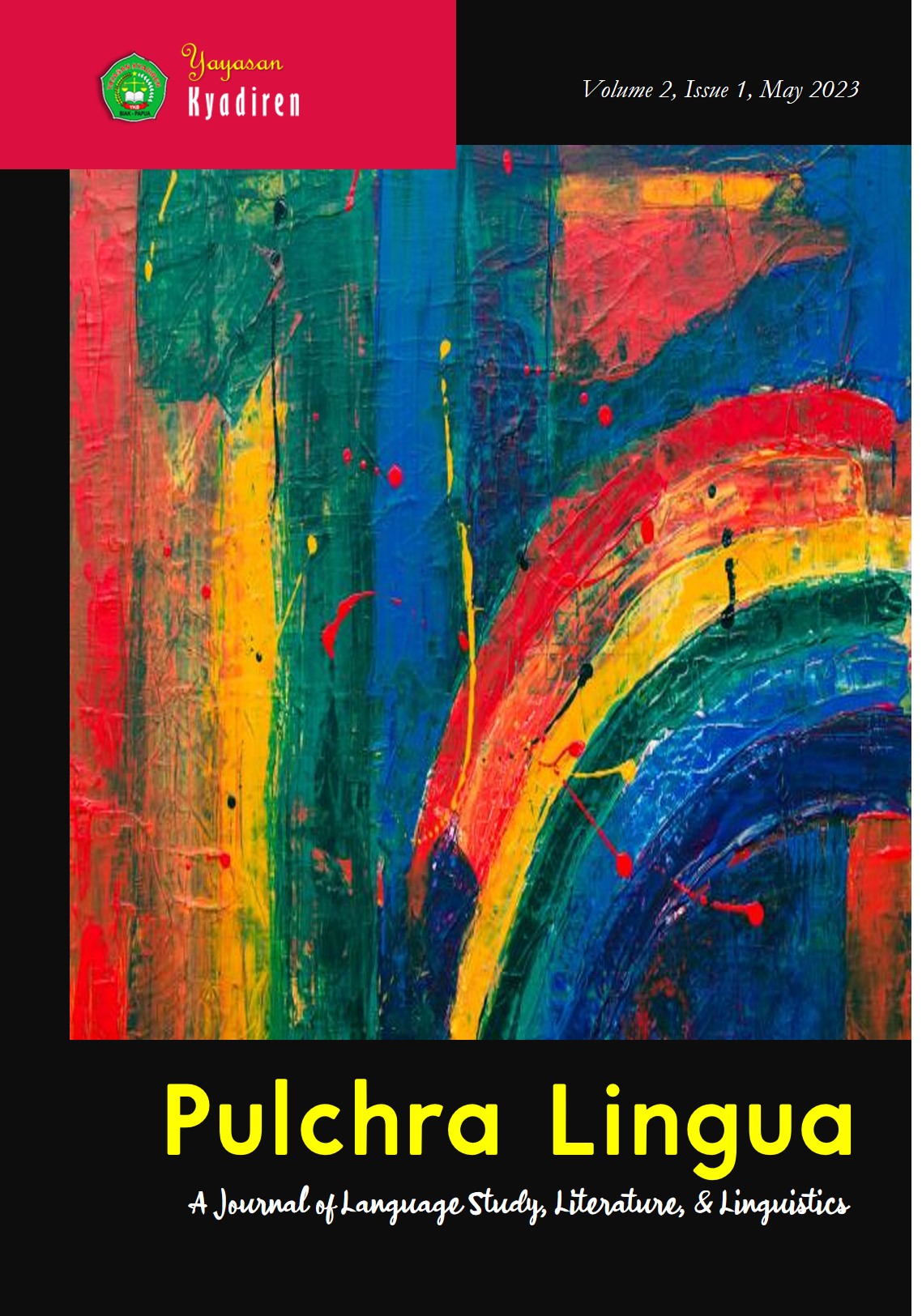Exploring Semantics and the Utilization of Figurative Language in the Song Lyrics of “21 Guns” by Green Day
DOI:
https://doi.org/10.58989/plj.v2i1.22Keywords:
Figurative Language, Translation, 21 GunsAbstract
Translation serves multiple purposes, encompassing the expression of emotions, the conveyance of ideas, and the ability to influence others. Figurative language plays a significant role in communicating feelings through the songs we encounter in our daily lives. This study adopts a descriptive qualitative approach to investigate this phenomenon. Content analysis is employed as the analytical technique, aiming to identify the distinct characteristics of messages conveyed through songs and the utilization of figurative language, such as metaphors, hyperboles, similes, euphemisms, and personifications. The findings reveal that the majority of lyrics within the song “21 Guns” contain implicit and profound meanings related to the physical and psychological impacts of war, including the destruction of homes and the loss of soldiers' lives. Furthermore, the song employs a diverse range of language styles, incorporating hyperbole and personification, which contribute to its captivating and meaningful nature
References
Journals
Ahmed, E. A. A. A. (2022). A Study of Figurative Language In Proverbs, With Special Reference To Simile, Metaphor, Personification, And Hyperbole. Egyptian Journal of English Language and Literature Studies, 11(1), 35–62. https://dx.doi.org/10.21608/ejels.2022.285062
Amanah, F. P. (2022). Critical Discourse Analysis on Camila Cabello’s Song Lyric: “Havana.” Pulchra Lingua: A Journal of Language Study, Literature & Linguistics, 1(1), 01–13.
Aziz, M. F., & Jayaputri, H. E. (2023). Schmitt, N., & Rodgers, MPH (Eds.) An Introduction to Applied Linguistics Routledge, Taylor & Francis. 2020. 404 pp. Theory and Practice of Second Language Acquisition, 9(1), 1-5.
Cahyo, A. N., Manullang, T. A. A., & Isnan, M. (2020). Analisis Penggunaan Gaya Bahasa Sarkasme pada Lagu Bahaya Komunis Karangan Jason Ranti. Asas: Jurnal Sastra, 9(1), 6–22. https://doi.org/10.24114/ajs.v9i1.18329
Dolník, J. (2022). Equal language communication. Journal of Linguistics, 73(1), 27–39. https://doi.org/10.2478/jazcas-2022-0025
Fitch, W. T. (2011). Unity and diversity in human language. Philos Trans R Soc Lond B Biol Sci, 366(1563), 376–388. https://doi.org/10.1098/rstb.2010.0223
Gibson, E., Futrell, R., Piantadosi, S. P., Dautriche, I., Mahowald, K., Bergen, L., & Levy, R. (2019). How Efficiency Shapes Human Language. Trends in Cognitive Sciences, 1–40. https://doi.org/10.1016/j.tics.2019.02.003
Helmi, A., Utari, W., Putri, A. Y., Barus, F. L., & Luthifah, A. (2021). Metafora dalam Lirik Lagu “Mendarah” oleh Nadin Amizah. Lingua Susastra, 2(1), 1–8. https://doi.org/10.24036/ls.v2i1.19
Kafi, L. N., & Degaf, A. (2021). Euphemism And Dysphemism Strategies in Donald Trump’s Speech At Sotu 2020. International Journal of Humanity Studies, 4(2), 194–207. https://doi.org/10.24071/ijhs.v4i2.3205
Putra, R. A. (2022). A Critical Discourse Analysis of How Background Music Exhilarates Metal Gear Rising: Revengeance’s Narratives. Pulchra Lingua: A Journal of Language Study, Literature & Linguistics, 1(2), 131-145. https://doi.org/10.58989/plj.v1i2.13
Sari, P. I. C. M., Santika, I. D. A. D. M., & Juniartha, I. W. (2022). Hyperbole In Song Lyrics of Sempiternal Album by Bring Me the Horizon. Journal of Language and Applied Linguistics, 3(1), 74–84. https://doi.org/10.22334/traverse.v3i1.57
Swarniti, N. W. (2022). Analysis of Figurative Language in “Easy On Me” Song Lyric. Retorika: Jurnal Ilmu Bahasa, 8(1), 13–18. https://doi.org/10.55637/jr.8.1.4708.13-18
Syahril, U., Syahrial, S., & Kartika, D. (2020). Gaya Bahasa Kiasan Dan Makna Kias Dalam Lirik Lagu Jepang Karya L’arc-En-Ciel. Abstract of Undergraduate Research, Faculty of Humanities, Bung Hatta University, 2(3), 33–34. https://ejurnal.bunghatta.ac.id/index.php/JFIB/article/view/17581
Proceedings
Chakrabarty, T., Saakyan, A., Ghosh, D., & Muresan, S. (2022). FLUTE: Figurative Language Understanding through Textual Explanations. Computation and Language, 1–21. https://doi.org/10.48550/arXiv.2205.12404
Kim, N., & Linzen, T. (2020). COGS: A Compositional Generalization Challenge Based on Semantic Interpretation Processing. Conference on Empirical Methods in Natural Language, 9087–9105. http://dx.doi.org/10.18653/v1/2020.emnlp-main.731
Liu, E., Cui, C., Zheng, K., & Neubig, G. (2022). Testing the Ability of Language Models to Interpret Figurative Language. Computation and Language, 1–16. https://doi.org/10.48550/arXiv.2204.12632
Books
Abrams, M. H., & Harpham, G. (2014). A Glossary of Literary Terms (11th ed.). Cengage Learning.
Kennedy, X. J., & Gioia, D. (2009). Introduction to Poetry (13th ed.). Pearson Education.
Kenneth Leslie Knickerbocker, & Reninger, H. W. (1963). Interpreting Literature. Holt, Rinehart and Winston.
Kreidler, C. W. (1998). Introducing English Semantics. Psychology Press: Taylor & Francis Group.
Lakoff, G. (1993). The Contemporary Theory of Metaphor. In A. Ortony (Ed.), Metaphor and Thought (pp. 202–251). Cambridge University Press.
Pradopo, R. D. (2017). Analisis Strata Norma dan Analisis Struktural dan Semiotik. Gadjah Mada University Press.
Downloads
Published
How to Cite
Issue
Section
License
Copyright (c) 2023 Dimas Adika, Putu Agus Budiarsana

This work is licensed under a Creative Commons Attribution-ShareAlike 4.0 International License.






